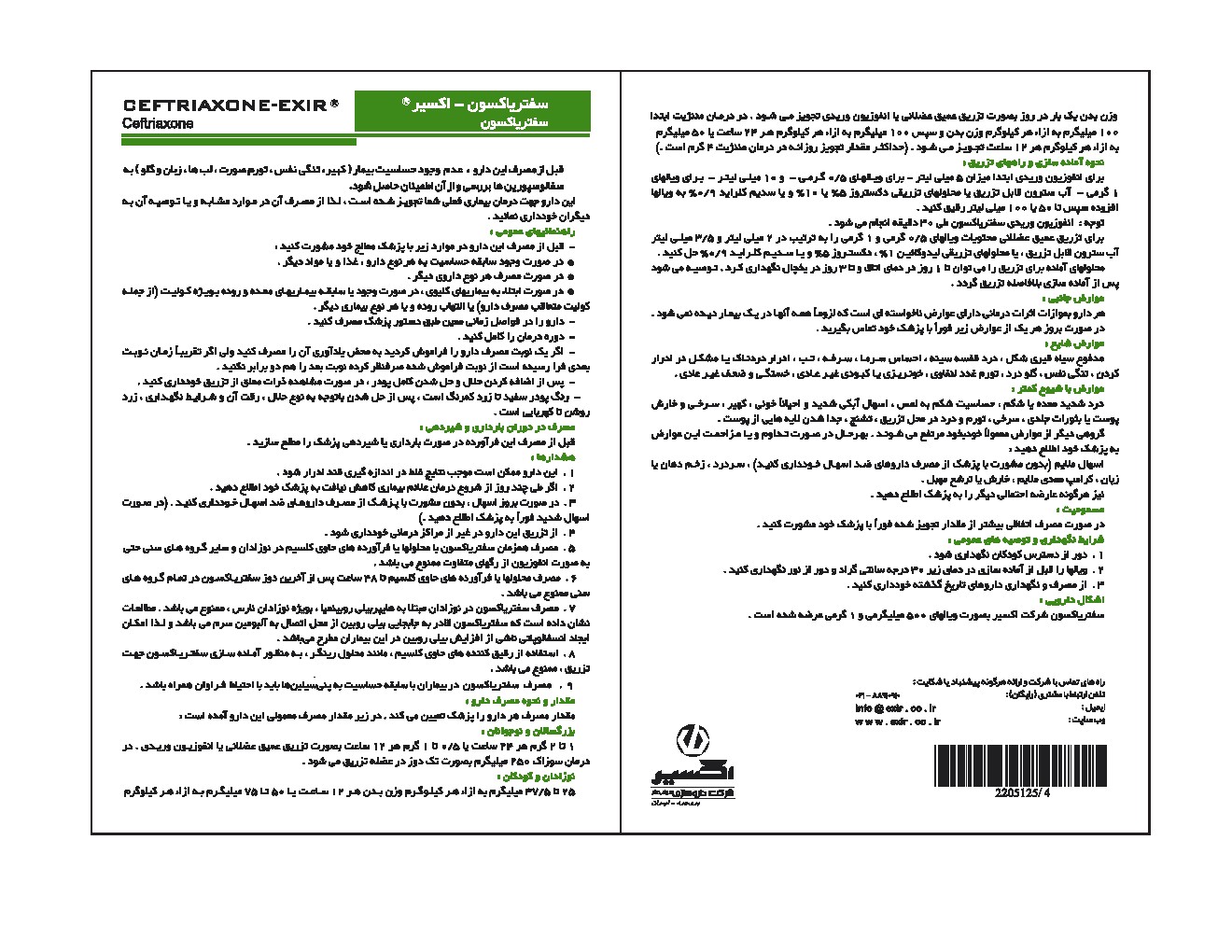CEFTRIAXONE 1g, 500mg-EXIR
Vial Ceftriaxone 1g, 500mg ( contains strile powder for injection)

| Generic Name of Product | Brand Name | Dosage Form | Strength | Pharmacologic Group | Therapeutic Group | Unit Per Pack |
| Ceftriaxone | Loraxone | Vial | 500/1000 | Cephalosporin | Antibacterial Agent | 20 |
Indications And Usage |
11) Surgical prophylaxis: The preoperative administration of a single 1 gm dose of ceftriaxone may reduce the incidence of postoperative infections in patients undergoing surgical procedures classified as contaminated or potentially contaminated (e.g., vaginal or abdominal hysterectomy or cholecystectomy for chronic calculous cholecystitis in high-risk patients, such as those over 70 years of age, with acute cholecystitis not requiring therapeutic antimicrobials, obstructive jaundice or common duct bile stones) and in surgical patients for whom infection at the operative site would present serious risk (e.g., during coronary artery bypass surgery). Although ceftriaxone has been shown to have been as effective as cefazolin in the prevention of infection following coronary artery bypass surgery, no placebo-controlled trials have been conducted to evaluate any cephalosporin antibiotic in the prevention of infection following coronary artery bypass surgery. | |
Administration |
No dosage adjustment is necessary for patients with impairment of renal or hepatic function. | |
Contraindications |
A small number of cases of fatal outcomes in which a crystalline material was observed in the lungs and kidneys at autopsy have been reported in neonates receiving ceftriaxone and calcium-containing fluids. In some of these cases, the same intravenous infusion line was used for both ceftriaxone and calcium-containing fluids and in some a precipitate was observed in the intravenous infusion line. At least one fatality has been reported in a neonate in whom ceftriaxone and calcium-containing fluids were administered at different time points via different intravenous lines; no crystalline material was observed at autopsy in this neonate. There have been no similar reports in patients other than neonates. | |
Precautions | This medication contains ceftriaxone. Do not takeif you are allergic to ceftriaxone or any ingredients contained in this drug. | |
Adverse Reactions | Injection site reactions (swelling, redness, pain, a hard lump, or soreness), Eosinophilia, Increased blood platelets (thrombocytosis), Diarrhea, Elevated liver transaminases, Low white blood cell count (leukopenia), Rash, Increased blood urea nitrogen (BUN), Pain | |
Pregnancy and lactation | category: B | |
Renal and liver Impairment | - | |
Laboratory Tests | - |
Indications And Usage |
11) Surgical prophylaxis: The preoperative administration of a single 1 gm dose of ceftriaxone may reduce the incidence of postoperative infections in patients undergoing surgical procedures classified as contaminated or potentially contaminated (e.g., vaginal or abdominal hysterectomy or cholecystectomy for chronic calculous cholecystitis in high-risk patients, such as those over 70 years of age, with acute cholecystitis not requiring therapeutic antimicrobials, obstructive jaundice or common duct bile stones) and in surgical patients for whom infection at the operative site would present serious risk (e.g., during coronary artery bypass surgery). Although ceftriaxone has been shown to have been as effective as cefazolin in the prevention of infection following coronary artery bypass surgery, no placebo-controlled trials have been conducted to evaluate any cephalosporin antibiotic in the prevention of infection following coronary artery bypass surgery. | |
Administration |
No dosage adjustment is necessary for patients with impairment of renal or hepatic function. | |
Contraindications |
A small number of cases of fatal outcomes in which a crystalline material was observed in the lungs and kidneys at autopsy have been reported in neonates receiving ceftriaxone and calcium-containing fluids. In some of these cases, the same intravenous infusion line was used for both ceftriaxone and calcium-containing fluids and in some a precipitate was observed in the intravenous infusion line. At least one fatality has been reported in a neonate in whom ceftriaxone and calcium-containing fluids were administered at different time points via different intravenous lines; no crystalline material was observed at autopsy in this neonate. There have been no similar reports in patients other than neonates. | |
Precautions | This medication contains ceftriaxone. Do not takeif you are allergic to ceftriaxone or any ingredients contained in this drug. | |
Adverse Reactions | Injection site reactions (swelling, redness, pain, a hard lump, or soreness), Eosinophilia, Increased blood platelets (thrombocytosis), Diarrhea, Elevated liver transaminases, Low white blood cell count (leukopenia), Rash, Increased blood urea nitrogen (BUN), Pain | |
Pregnancy and lactation | category: B | |
Renal and liver Impairment | - | |
Laboratory Tests | - |

